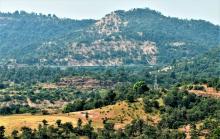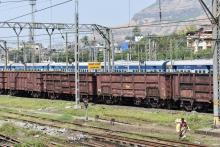1974 found me posted as the Divisional Assistant Mechanical Engineer (DAME) at the Diesel Loco Shed at Kankaria, Ahmedabad. I was an Assistant Officer but the ‘Divisional’ prefix meant that I reported directly to the DS (now called DRM) and not through any intermediate officer. Kankaria was a small shed homing 15 WDS4B locomotives that provided all shunting services in the Ahmedabad area. Ahmedabad then was not a separate division but part of Vadodara Division.
With a good set of supervisors and competent staff, work was satisfying and without undue pressure. The only dark cloud was the General Strike that had been announced by the All India Railwaymens’ Federation (AIRF), the non-Congress affiliated Railway Trade Union lead by the indomitable George Fernandes. In anticipation of the strike, the railways embodied all its Territorial Army (TA) units and positioned them at key locations across the vast network. My unit, the 1033 Railway Engineers (TA), was sent to the Central Railway and based at Bhusaval in early April, well before the actual strike started.
For the next month, we played a waiting game. Each TA unit (or Battalion to use the correct terminology) was geared to run 8 UP and 8 DN trains on a 200-kilometer section. We had the capability to maintain the track and man two terminal stations as well as 3 to 4 stations en route. We also had manpower to maintain the rolling stock for running these trains. Our total strength was about 1400 men, of whom about a hundred were regular army personnel and the rest railwaymen-turned-armymen. We wore regular army uniforms and were covered by the Army Act during this period. We carried regulation army weapons like rifles and sub-machine guns.
Our prolonged wait ended on the 8th of May 1974. The strike broke - it was then said to be one of the largest strikes ever seen the world over. Contrary to expectations, Bhusaval Division was not affected to a great extent and trains continued to run. However, news from Bombay (now Mumbai) was grim: being the stronghold of George Fernandes, the strike was total on Bombay Division of the Central Railway. We were ordered to move immediately to Bombay to help run trains there.
The main body of our Battalion moved to Bombay proper and camped at VT station (now Chhatrapati Shivaji Maharaj Terminus). A small contingent of drivers (now called Loco Pilots), their assistants and Guards was posted at Igatpuri, the junction of Bhusaval and Bombay Divisions. The picturesque Igatpuri also happens to be at the summit of the Thule Ghat, i.e. the 15-kilometer steep ascent from Kasara to Igatpuri on the Bombay-Bhusaval line. The plan that had been conceived was that our Battalion would run 8 trains per day in each direction primarily to create a psychological atmosphere that trains were running. Four of these trains would be passenger while the rest would be freight. The Bombay contingent would run the trains from VT to Igatpuri while the small contingent at Igatpuri would cover the Thule Ghat itself. I was posted at Igatpuri.
At that time, the line was electrified from Bombay to Igatpuri while the line beyond was not. Igatpuri was thus an important point where all trains changed their traction from diesel or steam to electric. Most of the drivers we had were diesel only and since Bombay Division was on total strike, electric locos were not available. The result was that we had to cover the Ghat section with diesels from Itarsi.
We reached Igatpuri late at night. All staff was on strike except the Station Master, an avuncular looking but active Sikh - I forget his name. We sat with him till late at night to work out how we would run the station and the formidable Ghat section. Manning the station was no problem as we had the necessary staff. Rules of working the Ghat were explained to the running crews of the TA so that they would know what to expect and what to do. It was also ne
cessary to know the road, i.e. the section itself: what was visibility like at each point, where were the grades, the curves, sighting of signals, and so on. Normal drivers have to cover a section as passengers with a regular driver at night and during the day to learn the road. We did not have the luxury of time to go through the whole cycle. All that we did was that the next day, three sets of crews were put on a light diesel loco and sent up and down the ghat twice. We planned to run trains during the day only, so that night road learning was not required. These three sets of crew worked the first few trains, and carried one extra crew with them, so that the latter also experienced the section and learned the road.
While passenger trains are easy, the real problem owing to their weight is the freight trains. We decided not to take the risk of running a complete freight train down the ghat. We broke up each train into three parts and ran each part with a single loco down the ghat while we used a banker as well while coming up. The system soon stabilised and within 3-4 days, we were running the eight trains that we were required to run.
As it usually happens even in regular working, after about ten days, we ran short of drivers. It was then that I found myself being booked as a driver to work one of the freight trains (1/3rd of it) down the ghat with a WDM2 class loco of Itarsi Diesel Shed. I don’t remember the loco’s number but found that it had come out of Periodical overhaul about 4 months earlier and appeared to be in good condition. I had a regular TA Assistant with me. I had already foot-plated on the section and thus, theoretically at least, I knew the road. I am mentioning the road repeatedly as in normal service, a driver is not permitted to run a train independently till it is certified by an Inspector that he knows the road.
I told the assistant that I would not drive beyond 40 kmph although the sectional speed was higher. I told him to tell me when the speed reached 40 so that I could control the train.
The starter signal turned green, as did the advance starter. I shifted the throttle to notch one and then two. The loco lurched forward as it had only 1/3rd of its normal load. As we went past the advance starter, I could see the track going downward at an angle that we are not normally used to. I eased the throttle back to zero and allowed the train to roll down the steep ghat. I could see gradient boards announcing that the grade was now 1 in 37, the ruling grade of the Thule Ghat.
All ghat sections have what are called catch sidings. These are safety requirements wherein there are sidings at specific spots in the ghat descending direction. While the main line is going down, the siding takes you uphill on a very steep grade. On the Thule Ghat, the line is normally set for the siding and protected by a signal. The train is brought to a halt and only then the points are set for the straight and the signal lowered by a small cabin at the location can the driver proceed. As the cabin staff was also on strike, the arrangement was that the driver stopped the train and the assistant went over and set the points. After crossing the point, the train stopped again and the guard re-set the point for the catch siding.
The first catch siding comes quite soon after leaving Igatpuri. I was determined that my speed should not be too high so that I could stop before the signal. Therefore, I was quite pleased that the train was rolling down with dynamic braking on at a comfortable speed .
“Look at the speedometer,” the Assistant yelled to me in Hindi.
I looked and was aghast. What I had thought was a comfortable speed was touching a speeding 55 kmph. I applied the emergency brake. About this time, we could also see the stop signal of the first catch siding. It came closer to us at what felt like the speed of light but the train was not slowing down fast enough.
Ladies and Gentlemen, if I have been ever filled with total fear, it was at this time. With full braking on, there is nothing you can do but pray. If I had been shot through my heart at that moment, I would have survived as my heart was well in my mouth.
But, God is great! Just when we thought that all was lost and we would go right onto the catch siding, the train slowed and came to a stop only centimeters short of the line-changing points. I could see that the Assistant was also sighing with relief. He got off the loco and changed the points and we were on our way again.
The rest of the journey was uneventful and we reached Kasara in one piece. The return journey was no problem at all as we had a banker. Since we did not have any locotrol or similar remote multiple operation facility in those days, we kept tabs with the rear banker driver through a system of pre-arranged whistle codes.
I worked 2 more trains till the end of the strike on the 27th of May. Even if I had worked triple that number of trains, no trip would have caught up with the excitement of the first journey.


